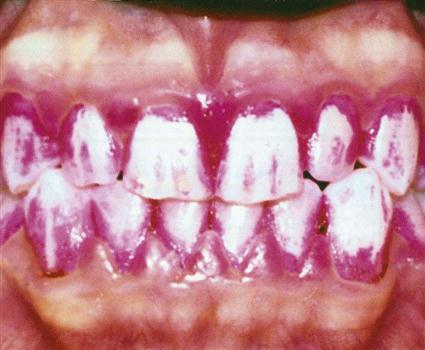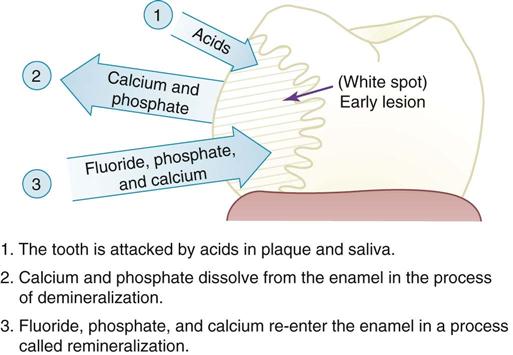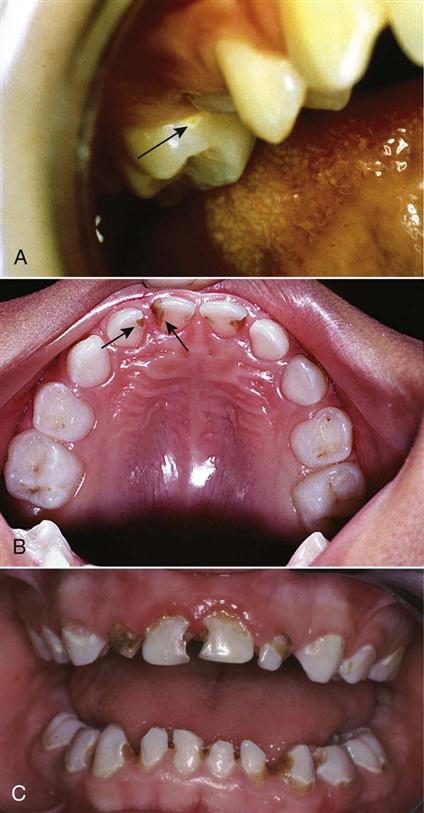Dental Caries
Learning Outcomes
On completion of this chapter, the student will be able to achieve the following objectives:
• Pronounce, define, and spell the Key Terms.
• Name the most common chronic disease in children.
• Identify dental caries as an infectious disease.
• Explain the process of dental caries.
• Identify the risk factors for dental caries.
• Explain the risk factors for early childhood caries.
• Explain the consequences of early childhood caries.
• Describe the purpose of CAMBRA.
• Explain the purpose of caries activity tests.
• Use the caries risk assessment form to determine caries risk.
• Describe the types of caries detection devices.
• Describe the method used to administer the saliva flow rate test.
• Describe the modes of transmission of dental caries.
• Describe the methods of controlling dental caries.
• Identify the infective agent in the caries process.
• Explain the role of saliva in oral health.
• Describe the relationship between diet and dental caries.
• Explain the demineralization and remineralization processes.
• Distinguish between root caries and smooth surface caries.
• Describe the advantages and disadvantages of the laser caries detection devices.
Performance Outcomes
On completion of this chapter, the student will be able to meet competency standards in the following skills:
• Perform a caries detection procedure utilizing an electronic caries detection device.
• Perform a caries risk test and compare the density of bacterial colonies versus evaluation pictures.
Electronic Resources
![]() Additional information related to content in Chapter 13 can be found on the companion Evolve Web site.
Additional information related to content in Chapter 13 can be found on the companion Evolve Web site.
Key Terms
CAMBRA Caries management by risk assessment.
Caries (KAR-eez) The infectious disease process of tooth decay.
Caries Risk Test (CRT) Test for cariogenic bacteria.
Cariology (KAR-ee-all-o-gee) The science and study of dental caries.
Carious (KAR-ee-us) lesion White spots, brown spots, decay on tooth surfaces.
Cavitation (ka-vi-TAY-shun) Formation of a cavity or hole.
Demineralization (dee-min-ur-ul-i-ZAY-shun) Loss of minerals from the tooth.
Early childhood caries (ECC) Decay in any primary teeth.
Evidence based Information based upon documented evidence from critically reviewed research.
Fermentable (fur-MEN-tuh-bul) carbohydrates Simple carbohydrates, such as sucrose, fructose, lactose, and glucose.
Fluoride (FLOOR-ide) Mineral used in dental products to make teeth more resistant to decay.
Incipient (in-SIP-ee-ent) caries Tooth decay that is beginning to form or become apparent.
Lactobacilli (lak-toe-buh-SIL-eye) Bacteria that produce lactic acid from carbohydrates.
Mutans streptococci (strep-toe-KOK-sye) Type of bacteria primarily responsible for caries.
Pellicle (PEL-i-kul) Thin film coating of salivary materials deposited on tooth surfaces.
Plaque (plak) Soft deposit on teeth that consists of bacteria and bacterial by-products.
Rampant (RAM-punt) caries Decay that develops rapidly and is widespread throughout the mouth.
Remineralization Replacement of minerals in the tooth.
Saliva flow rate test Determines flow rate of saliva in milliliters per minute.
Xerostomia (zeer-oe-STOE-mee-uh) Dryness of the mouth caused by reduction of saliva.
Xylitol (ZY-li-toll) Ingredient in chewing gum that has an antibacterial effect against decay-causing bacteria.
Dental caries (tooth decay) is an infectious and communicable disease. It is a worldwide health concern, affecting humans of all ages. Dental caries is the single most common chronic disease in children. In fact, five times more children in the United States have untreated dental disease than have childhood asthma. This results in more than 50 million missed school hours every year. Caries is not just a child’s disease. Because of recession of the gingival tissues, many older adults experience root caries. This chapter discusses cariology, which includes the causes of caries, the process by which caries occurs, and the science and practice of caries management and prevention.
Caries has plagued humankind since the beginning of recorded history. Since the late nineteenth century, dentists have been fighting tooth decay by drilling out the decayed tooth structure and filling the tooth with a restorative material. Although this treatment eliminates decay that is already present, it does nothing to lower levels of bacteria in the mouth that may cause additional caries. Today, the emphasis in fighting caries is shifting from the traditional approach of restoring (filling) teeth to newer strategies of managing caries by determining the risk for caries in an individual, and then implementing appropriate methods of preventing future caries. Advances in science and new technologies have placed the emphasis on prevention and early intervention.
Bacterial Infection
Caries is a transmissible bacterial infection. The two specific groups of bacteria in the mouth that are responsible for caries are the mutans streptococci (MS) (Streptococcus mutans) and the lactobacilli (LB).
MS, which are considered to be major pathogenic (disease-producing) bacteria, are found in relatively large numbers in dental plaque. The presence of LB in a patient’s mouth indicates that the patient has a high sugar intake. MS and LB, separately or together, are the primary causative agents of caries.
It is important to note that the oral cavity of a newborn does not contain MS. However, these bacteria are transmitted through contact with saliva (most frequently the mother’s saliva) to the infant. Mothers are the most common source of disease-causing MS because of the close and frequent contact that takes place between mother and child during the first few years. For example, a mother kisses her baby and may also taste food on a spoon before giving it to her baby. Science has proved that when mothers have high counts of MS in their mouths, their infants have high counts of the same bacteria in their mouths. Children also may be infected by a caregiver or even by siblings.
Remember, caries is an infectious disease. When the number of caries-causing bacteria in the mouth increases, the risk for developing caries also increases.
Dental Plaque
Dental plaque is a colorless, soft, sticky coating that adheres to the teeth (Fig. 13-1). MS and LB live and multiply within the dental plaque. If toothbrushing and flossing are not thorough, plaque remains attached to the tooth. Even self-cleansing movements of the tongue, or rinsing and spraying of the mouth with water or mouthwash, will not dislodge the plaque.
If you were to look at plaque under a microscope, you would see colonies of bacteria embedded in an adhesive substance called the pellicle. Formation of plaque on a tooth concentrates millions of microorganisms on that tooth. A milligram of wet plaque may contain as many as 200 to 500 million microorganisms. A similar amount of saliva flowing through the oral cavity contains less than 1 percent of this number of organisms, so it is clear that bacteria in plaque that is attached to the tooth are a major part of the problem.
Enamel Structure
To gain an understanding of how bacterial infection leads to the caries process, it is important to review the structure of enamel. Enamel is the most highly mineralized tissue in the body, and it is stronger than bone. Refer to Chapter 8 for an in-depth discussion of the structure of enamel.
Enamel consists of microscopic crystals of hydroxyapatite arranged in structural layers or rods, also known as prisms. These crystals are surrounded by water, and primary teeth are made up of slightly more water than are permanent teeth. The water in enamel allows acids to flow into the tooth and minerals to flow out of the tooth. Carbonated apatite, a mineral in enamel, makes it easier for the tooth structure to dissolve.
The Caries Process
Caries is a disease that is caused by multiple factors (Fig. 13-2). For caries to develop, the following three factors must be present at the same time:
Bacteria in dental plaque feed on fermentable carbohydrates found in a regular diet, such as sugars (including fruit sugars) and cooked starch (e.g., bread, potatoes, rice, pasta). Just as human wastes are a by-product of eating, these bacteria produce acids as a by-product of their metabolism. Within about 5 minutes after eating or drinking, bacteria begin to produce acids as a by-product of their digesting your food. These acids can penetrate into the hard substance of the tooth and dissolve some of the minerals (calcium and phosphate). If acid attacks are infrequent and of short duration, saliva can help repair the damage by neutralizing the acids and supplying minerals and fluoride to replace those lost from the tooth. When fermentable carbohydrates are eaten frequently, more acid is produced and the risk for decay increases. If this process continues, caries develops.
Carious lesions can occur in four general areas of the tooth, as follows:
3 Root surface caries occurs on any surface of the exposed root.
4 Secondary caries, or recurrent caries, occurs on the tooth that surrounds a restoration.
Stages of Caries Development
It can take months or even years for a carious lesion to develop. Carious lesions occur when more minerals are lost (demineralization) from the enamel than are deposited (remineralization). Demineralization occurs when calcium and phosphate dissolve from hydroxyapatite crystals in the enamel. In remineralization, calcium and phosphate are redeposited in previously demineralized areas. The processes of demineralization and remineralization may occur without loss of tooth structure.
Dental caries is not simply a continual, cumulative loss of minerals from the tooth. Rather, caries is a dynamic, ongoing process that is characterized by alternating periods of demineralization and remineralization (Fig. 13-3).
Carious lesions develop in two distinct stages, as follows:
1 The first stage, incipient caries or incipient lesions, occurs when caries begins to demineralize the enamel (Fig. 13-4, A).
2 The second stage, the overt lesion, or frank lesion, is characterized by cavitation—the development of a cavity or a hole (Fig. 13-4, B).
Stay updated, free dental videos. Join our Telegram channel

VIDEdental - Online dental courses






